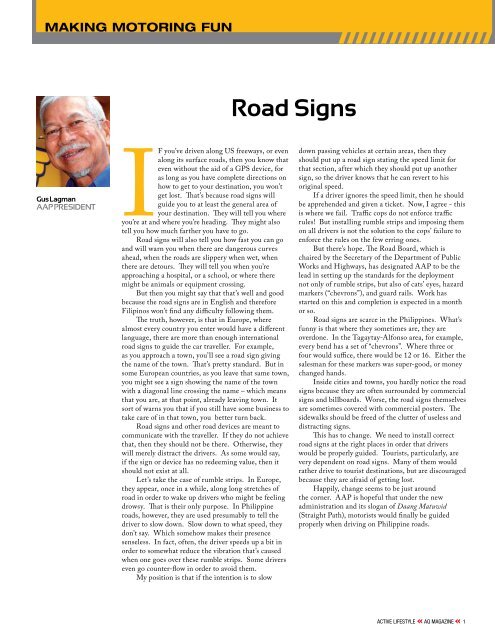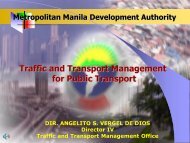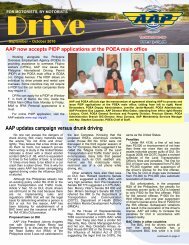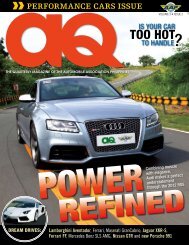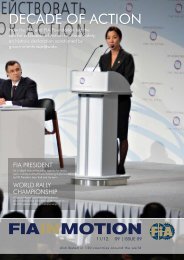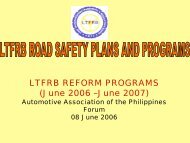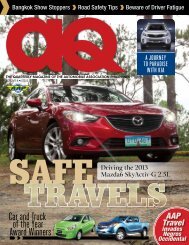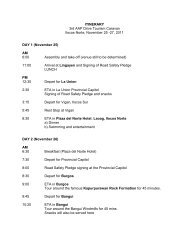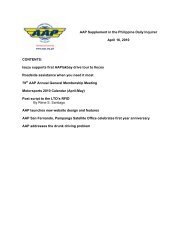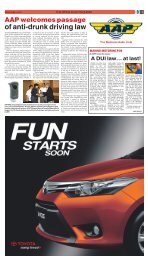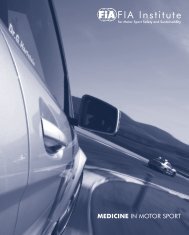Volume 2 Issue 1 - Automobile Association Philippines
Volume 2 Issue 1 - Automobile Association Philippines
Volume 2 Issue 1 - Automobile Association Philippines
Create successful ePaper yourself
Turn your PDF publications into a flip-book with our unique Google optimized e-Paper software.
MAKING MOTORING FUN<br />
Road Signs<br />
Gus Lagman<br />
AAP PRESIDENT<br />
IF you’ve driven along US freeways, or even<br />
along its surface roads, then you know that<br />
even without the aid of a GPS device, for<br />
as long as you have complete directions on<br />
how to get to your destination, you won’t<br />
get lost. That’s because road signs will<br />
guide you to at least the general area of<br />
your destination. They will tell you where<br />
you’re at and where you’re heading. They might also<br />
tell you how much farther you have to go.<br />
Road signs will also tell you how fast you can go<br />
and will warn you when there are dangerous curves<br />
ahead, when the roads are slippery when wet, when<br />
there are detours. They will tell you when you’re<br />
approaching a hospital, or a school, or where there<br />
might be animals or equipment crossing.<br />
But then you might say that that’s well and good<br />
because the road signs are in English and therefore<br />
Filipinos won’t find any difficulty following them.<br />
The truth, however, is that in Europe, where<br />
almost every country you enter would have a different<br />
language, there are more than enough international<br />
road signs to guide the car traveller. For example,<br />
as you approach a town, you’ll see a road sign giving<br />
the name of the town. That’s pretty standard. But in<br />
some European countries, as you leave that same town,<br />
you might see a sign showing the name of the town<br />
with a diagonal line crossing the name – which means<br />
that you are, at that point, already leaving town. It<br />
sort of warns you that if you still have some business to<br />
take care of in that town, you better turn back.<br />
Road signs and other road devices are meant to<br />
communicate with the traveller. If they do not achieve<br />
that, then they should not be there. Otherwise, they<br />
will merely distract the drivers. As some would say,<br />
if the sign or device has no redeeming value, then it<br />
should not exist at all.<br />
Let’s take the case of rumble strips. In Europe,<br />
they appear, once in a while, along long stretches of<br />
road in order to wake up drivers who might be feeling<br />
drowsy. That is their only purpose. In Philippine<br />
roads, however, they are used presumably to tell the<br />
driver to slow down. Slow down to what speed, they<br />
don’t say. Which somehow makes their presence<br />
senseless. In fact, often, the driver speeds up a bit in<br />
order to somewhat reduce the vibration that’s caused<br />
when one goes over these rumble strips. Some drivers<br />
even go counter-flow in order to avoid them.<br />
My position is that if the intention is to slow<br />
down passing vehicles at certain areas, then they<br />
should put up a road sign stating the speed limit for<br />
that section, after which they should put up another<br />
sign, so the driver knows that he can revert to his<br />
original speed.<br />
If a driver ignores the speed limit, then he should<br />
be apprehended and given a ticket. Now, I agree - this<br />
is where we fail. Traffic cops do not enforce traffic<br />
rules! But installing rumble strips and imposing them<br />
on all drivers is not the solution to the cops’ failure to<br />
enforce the rules on the few erring ones.<br />
But there’s hope. The Road Board, which is<br />
chaired by the Secretary of the Department of Public<br />
Works and Highways, has designated AAP to be the<br />
lead in setting up the standards for the deployment<br />
not only of rumble strips, but also of cats’ eyes, hazard<br />
markers (“chevrons”), and guard rails. Work has<br />
started on this and completion is expected in a month<br />
or so.<br />
Road signs are scarce in the <strong>Philippines</strong>. What’s<br />
funny is that where they sometimes are, they are<br />
overdone. In the Tagaytay-Alfonso area, for example,<br />
every bend has a set of “chevrons”. Where three or<br />
four would suffice, there would be 12 or 16. Either the<br />
salesman for these markers was super-good, or money<br />
changed hands.<br />
Inside cities and towns, you hardly notice the road<br />
signs because they are often surrounded by commercial<br />
signs and billboards. Worse, the road signs themselves<br />
are sometimes covered with commercial posters. The<br />
sidewalks should be freed of the clutter of useless and<br />
distracting signs.<br />
This has to change. We need to install correct<br />
road signs at the right places in order that drivers<br />
would be properly guided. Tourists, particularly, are<br />
very dependent on road signs. Many of them would<br />
rather drive to tourist destinations, but are discouraged<br />
because they are afraid of getting lost.<br />
Happily, change seems to be just around<br />
the corner. AAP is hopeful that under the new<br />
administration and its slogan of Daang Matuwid<br />
(Straight Path), motorists would finally be guided<br />
properly when driving on Philippine roads.<br />
ACTIVE LIFESTYLE<br />
AQ MAGAZINE 1


